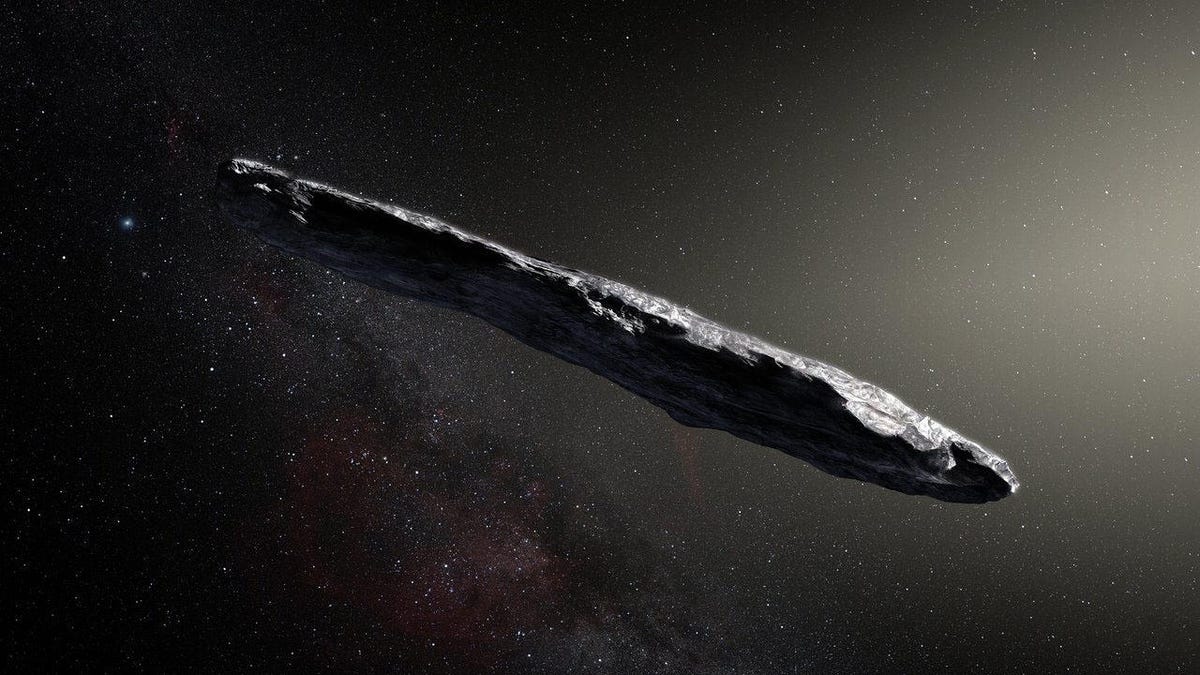Oumuamua is weird but isn't an alien ship, study finds
A comprehensive study aims to show that one of the strangest space rocks ever is just that and nothing else.

This artist's impression shows Oumuamua.
The bizarre cosmic object Oumuamua has fueled an ongoing science fight over whether the interstellar interloper is just an odd oblong space rock -- or an alien craft. The latest jab takes some of the solar wind out of the idea that Oumuamua is a space sail.
First spotted in 2017, Oumuamua went fully viral a year later when Harvard physicist Avi Loeb suggested it behaves like an artificial solar sail. The notion has been a controversial one among scientists. A new analysis, funded in part by NASA, throws perhaps the most serious shade yet at Loeb and others pushing the Oumuamua-as-alien-probe thesis.
"We have never seen anything like Oumuamua in our solar system. This thing is weird and admittedly hard to explain," University of Maryland research scientist Matthew Knight said Monday in a statement. "The alien spacecraft hypothesis is a fun idea, but our analysis suggests there is a whole host of natural phenomena that could explain it."
Knight is one of the leaders of the team that reported its findings in Monday's issue of Nature Astronomy.
Loeb co-authored his own paper released in November speculating that if Oumuamua were really a solar sail, it might explain its odd shape and acceleration on its way out of the solar system.
A solar sail is a type of spacecraft that uses solar radiation pressure for propulsion, just like the wind pushes a sailboat. The Planetary Society recently launched a small solar sail aboard a Falcon Heavy rocket, and Loeb chairs the advisory board for the Breakthrough Starshot initiative, which aims to send similar technology to Alpha Centauri.
Breakthrough Starshot's sister project, Breakthrough Listen, also checked Oumuamua for alien signals using radio telescopes but found no signs that it is artificial.
The new paper lays out how the observational data gathered for Oumuamua isn't consistent with an artificial solar sail. It also argues that the apparent lack of natural cometary gas jets that would explain its weird acceleration is more likely owed to the limited observations of the object than to alien technology.
It's worth noting that other scientists have also pushed back on the alien sail hypothesis and that other explanations have been posited. Some of them are even weirder than aliens, though, like the idea that Oumuamua could be a big hunk of dark matter.
The mystery of Oumuamua may never be fully solved to the satisfaction of all scientists. as the object is long gone and not expected to return to our solar system. But Knight is optimistic that data from the upcoming Large Synoptic Survey Telescope will help astronomers spot more interstellar visitors.
"In the next 10 years, we expect to begin seeing more objects like Oumuamua," Knight said. "That's when we'll start to know whether Oumuamua is weird, or common. If we find 10-20 of these things and Oumuamua still looks unusual, we'll have to reexamine our explanations."

